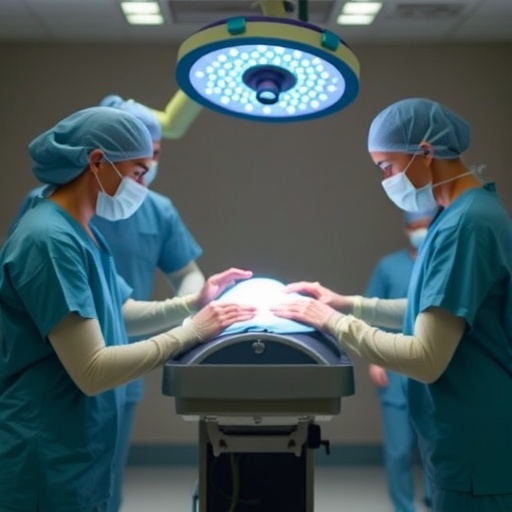In the relentless quest to treat devastating inherited brain disorders such as Tay-Sachs and Sandhoff diseases, a groundbreaking approach developed by researchers at Stanford Medicine has emerged, offering new hope where none previously existed. These rare lysosomal storage disorders, characterized by the progressive and fatal degeneration of neurons early in life, have long resisted effective treatment options. The scientific community has battled challenges in replacing dysfunctional brain cells with genetically healthy counterparts, primarily due to poor cell engraftment in the central nervous system and the risk of immune complications. However, the latest study, soon to be published in Nature, elucidates a novel method for replacing brain microglia—cells integral to brain health—with donor cells that are neither genetically matched nor subjected to the harsh systemic preconditioning traditionally required.
Tay-Sachs and Sandhoff diseases are rooted in mutations that cripple lysosomal enzyme function, key facilitators of cellular cleanup and recycling processes. Despite being rare, these conditions wreak profound neurological devastation, often leading to death within the first few years of life. Intriguingly, while neuron deterioration drives symptoms, immune cells in the brain called microglia paradoxically exhibit enzyme levels up to a thousand times higher than neurons. This conundrum led scientists to hypothesize that restoring normal lysosomal enzyme activity within microglia could indirectly rescue neurons, potentially slowing or halting disease progression.
Historically, attempts to correct these enzymatic deficits have involved hematopoietic stem cell transplantation—a procedure that eliminates the patient’s immune system, followed by intravenous infusion of healthy stem cells intended to repopulate the brain with functional microglia. Yet, the approach has been mired by toxic preconditioning regimens, limited cell engraftment in the brain, and serious immune-related side effects including graft-versus-host disease, where donor immune cells attack the recipient’s tissues. Furthermore, such transplants require genetically matched donors to minimize rejection, complicating and delaying treatment.
.adsslot_0ZYwQMLfC8{ width:728px !important; height:90px !important; }
@media (max-width:1199px) { .adsslot_0ZYwQMLfC8{ width:468px !important; height:60px !important; } }
@media (max-width:767px) { .adsslot_0ZYwQMLfC8{ width:320px !important; height:50px !important; } }
ADVERTISEMENT
The Stanford research team, led by Professor Marius Wernig and postdoctoral researcher Marius Mader, sought to circumvent these barriers by pioneering a brain-specific transplantation protocol that spares patients from systemic toxicity and immune complications. By combining localized brain irradiation with administration of a microglia-depleting agent, they created an open niche within the brain for new cells. This approach was complemented by the direct intracerebral injection of microglia precursor cells derived from non-genetically matched donors. To further prevent immune rejection, the scientists administered targeted immunosuppressive drugs to curtail activation of host immune cells that typically destroy foreign cells.
This meticulously orchestrated sequence achieved unprecedented engraftment: over 85% of microglia in treated mice brains were replaced by donor-derived cells persisting for at least eight months post-transplant. Remarkably, this was accomplished without full-body immune system ablation or graft-versus-host complications, demonstrating a safer, more clinically feasible alternative to traditional transplantation.
Mice afflicted with Sandhoff disease exhibited significant improvements following treatment. Whereas untreated controls survived a median of approximately 135 days, treated animals lived up to 250 days, with extended survival accompanied by restored motor functions and normal exploratory behaviors. While eventual hind leg paralysis occurred, the preservation of neurological function for an extended period represents a monumental leap in therapeutic potential.
A fascinating discovery emerged upon closer examination of tissue interactions: the corrected microglia appeared to secrete lysosomal enzymes into the extracellular environment, allowing neighboring neurons—still genetically deficient—to uptake these enzymes. This points to a previously underappreciated role of microglia in supporting neuronal health beyond their traditional immunological functions, suggesting that the success of this therapy hinges not solely on cell replacement but also on intercellular biochemical support.
Professor Wernig notes that their work addresses three critical challenges in treating lysosomal storage diseases: establishing efficient and durable brain-specific engraftment without toxic conditioning, employing unmatched donor cells capable of enzyme production without genetic modification, and circumventing immune rejection and graft-versus-host disease. This trifecta of innovations could transform the therapeutic landscape for patients with Tay-Sachs, Sandhoff, and potentially a broader range of neurodegenerative disorders.
Indeed, the implications may extend far beyond rare childhood diseases. The researchers speculate that lysosomal dysfunction observed in disorders like Alzheimer’s and Parkinson’s diseases might represent accelerated or analogous pathophysiological processes. If so, microglia replacement therapy could usher in a new era of treatment for common adult neurodegenerative diseases, offering hope to millions affected worldwide.
As the study advances toward human trials, it embodies a remarkable convergence of stem cell biology, immunology, and neuroscience. It exemplifies how a detailed understanding of cellular interactions within the brain microenvironment can inspire therapies that restore not merely cell populations but the intricate biochemical interdependencies vital for neural function.
This breakthrough reinvigorates optimism for families confronting previously untreatable neurogenetic diseases. The prospect of swiftly deployable, safe, and effective brain cell replacement therapy stands as a testament to innovation’s power to confront human suffering. While hurdles remain before clinical application, this work marks a pivotal stride toward conquering the neurological devastation wrought by lysosomal storage disorders.
Subject of Research: Brain microglia replacement therapy for lysosomal storage disorders (Tay-Sachs and Sandhoff diseases)
Article Title: Therapeutic genetic restoration through allogeneic brain microglia replacement
News Publication Date: 6-Aug-2025
Web References:
Stanford Medicine
Nature DOI Link
References:
Wernig, M., Mader, M., et al. (2025). Therapeutic genetic restoration through allogeneic brain microglia replacement. Nature. DOI: 10.1038/s41586-025-09461-6
Keywords: Stem cell implantation, Tay-Sachs disease, Neurodegenerative diseases, Microglia
Tags: brain immune cells replacementcell engraftment challengesgenetic engineering in neuroscienceinherited brain disorderslysosomal storage disordersmicroglia function in brain healthneurodegeneration treatmentneurological disease researchnovel therapeutic approachesSandhoff disease studyStanford Medicine researchTay-Sachs disease therapy





